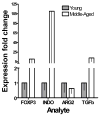Prostate cancer immunotherapy yields superior long-term survival in TRAMP mice when administered at an early stage of carcinogenesis prior to the establishment of tumor-associated immunosuppression at later stages
- PMID: 20006141
- PMCID: PMC2810316
- DOI: 10.1016/j.vaccine.2009.09.106
Prostate cancer immunotherapy yields superior long-term survival in TRAMP mice when administered at an early stage of carcinogenesis prior to the establishment of tumor-associated immunosuppression at later stages
Abstract
Prostate cancer immunotherapy clinical trials have been performed, but often in immunocompromised patients with limited clinical success. The study aim was to determine whether the stage of prostate cancer development at which immunization occurs affects vaccine efficacy, and if so which tumor-associated immunosuppressive mechanisms may be involved at later stages. Therapeutic vaccination of TRAMP mice with only precancerous PIN lesions confered superior protection to immunization after development of invasive carcinoma. The presence of Treg, upregulation of tumor indoleamine-2,3-dioxygenase and TGFbeta and an immunosuppressive intratumoral cytokine milieu were identified in more advanced prostate cancer. These results indicate that prostate cancer immunotherapy trials will be more successful if conducted in patients with less advanced disease.
Figures








References
-
- Jemal A, Thomas A, Murray T, Thun M. Cancer statistics, 2002. CA Cancer J Clin. 2002 Jan-Feb;52(1):23–47. - PubMed
-
- Tannock IF, Osoba D, Stockler MR, Ernst DS, Neville AJ, Moore MJ, et al. Chemotherapy with mitoxantrone plus prednisone or prednisone alone for symptomatic hormone-resistant prostate cancer: a Canadian randomized trial with palliative end points. J Clin Oncol. 1996 Jun;14(6):1756–64. - PubMed
-
- Hillman GG, Triest JA, Cher ML, Kocheril SV, Talati BR. Prospects of immunotherapy for the treatment of prostate carcinoma--a review. Cancer Detect Prev. 1999;23(4):333–42. - PubMed
-
- Crawford ED, Rosenblum M, Ziada AM, Lange PH. Hormone refractory prostate cancer. Urology. 1999 Dec;54(6A Suppl):1–7. - PubMed
-
- Noguchi M, Kobayashi K, Suetsugu N, Tomiyasu K, Suekane S, Yamada A, et al. Induction of cellular and humoral immune responses to tumor cells and peptides in HLA-A24 positive hormone-refractory prostate cancer patients by peptide vaccination. Prostate. 2003 Sep 15;57(1):80–92. - PubMed
Publication types
MeSH terms
Substances
Grants and funding
LinkOut - more resources
Full Text Sources
Medical

